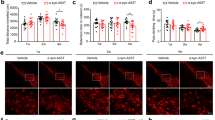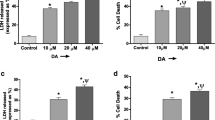Abstract
Objective
Intracellular formation of Lewy body (LB) is one of the hallmarks of Parkinson’s disease. The main component of LB is aggregated α-synuclein, present in the substantia nigra where iron accumulation also occurs. The present study was aimed to study the relationship between iron and α-synuclein aggregation.
Methods
SK-N-SH cells were treated with different concentrations of ferric iron for 24 h or 48 h. MTT assay was conducted to determine the cell viability. Thioflavine S staining was used to detect α-synuclein aggregation.
Results
With the increase of iron concentration, the cell viability decreased significantly. At the concentrations of 5 mmol/L and 10 mmol/L, iron induced α-synuclein aggregation more severely than at the concentration of 1 mmol/L. Besides, 48-h treatment-induced aggregation was more severe than that induced by 24-h treatment, at the corresponding iron concentrations.
Conclusion
Ferric iron can induce α-synuclein aggregation, which is toxic to the cells, in a dose- and time-dependent way.
摘要
目的
帕金森氏病的一个重要标志是胞浆内路易小体的形成。 路易小体的主要成分是α- 突触核蛋白的聚集体, 它和铁的积聚一同存在于黒质区。 本实验旨在研究铁和α- 突触核蛋白聚集的关系。
方法
SK-N-SH 细胞在不同浓度的三价铁作用下, 分别孵育24 h 或48 h, 用MTT 法和硫磺素S 染色法分别检测细胞存活率、 观察α- 突触核蛋白的聚集情况。
结果
随着铁离子浓度的升高, 细胞存活率显著下降。 其中5 mmol/L 和10 mmol/L 三价铁引起的α- 突触核蛋白的聚集相较于1 mmol/L 的三价铁引起的聚集更为严重。 此外, 在同一浓度的三价铁作用下, 孵育48 h引起的聚集比孵育24 h引起的聚集更严重。
结论
铁离子诱发的α-突触核蛋白的聚集具有剂量和时间的依赖性, 并且α- 突触核蛋白的聚集介导了铁的毒性作用。
Similar content being viewed by others
References
Halliday GM, Del Tredici K, Braak H. Critical appraisal of brain pathology staging related to presymptomatic and symptomatic cases of sporadic Parkinson’s disease. J Neural Transm Suppl 2006, 70: 99–103.
Shults CW. Lewy bodies. Proc Natl Acad Sci U S A 2006, 103: 1661–1668.
Spillantini MG, Schmidt ML, Lee VM, Trojanowski JQ, Jakes R, Goedert M. α-Synuclein in Lewy bodies. Nature 1997, 388: 839–840.
Iwai A, Masliah E, Yoshimoto M, Ge N, Flanagan L, de Silva HA, et al. The precursor protein of non-Aβ component of Alzheimer’s disease amyloid is a presynaptic protein of the central nervous system. Neuron 1995, 14: 467–475.
Wislet-Gendebien S, D’souza C, Kawarai T, St George-Hyslop P, Westaway D, Fraser P, et al. Cytosolic proteins regulate α-synuclein dissociation from presynaptic membranes. J Biol Chem 2006, 281: 32148–32155.
Friedlich AL, Tanzi RE, Rogers JT. The 5′-untranslated region of Parkinson’s disease α-synuclein messengerRNA contains a predicted iron responsive element. Mol Psychiatry 2007, 12: 222–223.
Kruger R, Kuhn W, Muller T, Woitalla D, Graeber M, Kosel S, et al. Ala30Pro mutation in the gene encoding α-synuclein in Parkinson’s disease. Nat Genet 1998, 18: 106–108.
Polymeropoulos MH, Lavedan C, Leroy E, Ide SE, Dehejia A, Dutra A, et al. Mutation in the α-synuclein gene identified in families with Parkinson’s disease. Science 1997, 276: 2045–2047.
Zarranz JJ, Alegre J, Gomez-Esteban JC, Lezcano E, Ros R, Ampuero I, et al. The new mutation, E46K, of α-synuclein causes Parkinson and Lewy body dementia. Ann Neurol 2004, 55: 164–173.
Singleton AB, Farrer M, Johnson J, Singleton A, Hague S, Kachergus J, et al. α-Synuclein locus triplication causes Parkinson’s disease. Science 2003, 302: 841.
Dexter DT, Wells FR, Lees AJ, Agid F, Agid Y, Jenner P, et al. Increased nigral iron content and alterations in other metal ions occurring in brain in Parkinson’s disease. J Neurochem 1989, 52: 1830–1836.
Good PF, Olanow CW, Perl DP. Neuromelanin-containing neurons of the substantia nigra accumulate iron and aluminum in Parkinson’s disease: a LAMMA study. Brain Res 1992, 593: 343–346.
Martin WR, Wieler M, Gee M. Midbrain iron content in early Parkinson disease: a potential biomarker of disease status. Neurology 2008, 70: 1411–1417.
Oakley AE, Collingwood JF, Dobson J, Love G, Perrott HR, Edwardson JA, et al. Individual dopaminergic neurons show raised iron levels in Parkinson disease. Neurology 2007, 68: 1820–1825.
Riederer P, Sofic E, Rausch WD, Schmidt B, Reynolds GP, Jellinger K, et al. Transition metals, ferritin, glutathione, and ascorbic acid in parkinsonian brains. J Neurochem 1989, 52: 515–520.
Zecca L, Berg D, Arzberger T, Ruprecht P, Rausch WD, Musicco M, et al. In vivo detection of iron and neuromelanin by transcranial sonography: a new approach for early detection of substantia nigra damage. Mov Disord 2005, 20: 1278–1285.
Wang J, Jiang H, Xie JX. Time dependent effects of 6-OHDA lesions on iron level and neuronal loss in rat nigrostriatal system. Neurochem Res 2004, 29: 2239–2243.
Jiang H, Luan Z, Wang J, Xie J. Neuroprotective effects of iron chelator Desferal on dopaminergic neurons in the substantia nigra of rats with iron-overload. Neurochem Int 2006, 49: 605–609.
Wang J, Jiang H, Xie JX. Ferroportin1 and hephaestin are involved in the nigral iron accumulation of 6-OHDA-lesioned rats. Eur J Neurosci 2007, 25: 2766–2772.
Ostrerova-Golts N, Petrucelli L, Hardy J, Lee JM, Farer M, Wolozin B. The A53T α-synuclein mutation increases irondependent aggregation and toxicity. J Neurosci 2000, 20: 6048–6054.
Golts N, Snyder H, Frasier M, Theisler C, Choi P, Wolozin B. Magnesium inhibits spontaneous and iron-induced aggregation of α-synuclein. J Biol Chem 2002, 277: 16116–16123.
Bharathi, Indi SS, Rao KS. Copper- and iron-induced differential fibril formation in α-synuclein: TEM study. Neurosci Lett 2007, 424: 78–82.
Lee HJ, Shin SY, Choi C, Lee YH, Lee SJ. Formation and removal of α-synuclein aggregates in cells exposed to mitochondrial inhibitors. J Biol Chem 2002, 277: 5411–5417.
Junxia X, Hong J, Wenfang C, Ming Q. Dopamine release rather than content in the caudate putamen is associated with behavioral changes in the iron rat model of Parkinson’s disease. Exp Neurol 2003, 182: 483–489.
Jenner P, Olanow CW. The pathogenesis of cell death in Parkinson’s disease. Neurology 2006, 66: S24–36.
Zhang S, Wang J, Song N, Xie J, Jiang H. Up-regulation of divalent metal transporter 1 is involved in 1-methyl-4-phenylpyridinium MPP+-induced apoptosis in MES23.5 cells. Neurobiol Aging 2009, 30: 1466–1476.
Yuan H, Zheng JC, Liu P, Zhang SF, Xu JY, Bai LM. Pathogenesis of Parkinson’s disease: oxidative stress, environmental impact factors and inflammatory processes. Neurosci Bull 2007, 2: 125–130.
Hirsch EC, Brandel JP, Galle P, Javoy-Agid F, Agid Y. Iron and aluminum increase in the substantia nigra of patients with Parkinson’s disease: an X-ray microanalysis. J Neurochem 1991, 56: 446–451.
He Y, Lee T, Leong SK. Time course of dopaminergic cell death and changes in iron, ferritin and transferrin levels in the rat substantia nigra after 6-hydroxydopamine (6-OHDA) lesioning. Free Radic Res 1999, 31: 103–112.
He Y, Thong PS, Lee T, Leong SK, Shi CY, Wong PT, et al. Increased iron in the substantia nigra of 6-OHDA induced parkinsonian rats: a nuclear microscopy study. Brain Res 1996, 735: 149–153.
Ma ZG, Wang J, Jiang H, Liu TW, Xie JX. Myricetin reduces 6-hydroxydopamine-induced dopamine neuron degeneration in rats. Neuroreport 2007, 18: 1181–1185.
Mochizuki H, Imai H, Endo K, Yokomizo K, Murata Y, Hattori N, et al. Iron accumulation in the substantia nigra of 1-methyl-4-phenyl-1,2,3,6-tetrahydropyridine (MPTP)-induced hemiparkinsonian monkeys. Neurosci Lett 1994, 168: 251–253.
Temlett JA, Landsberg JP, Watt F, Grime GW. Increased iron in the substantia nigra compacta of the MPTP-lesioned hemiparkinsonian African green monkey: evidence from proton microprobe elemental microanalysis. J Neurochem 1994, 62: 134–146.
Wang J, Xu HM, Yang HD, Du XX, Jiang H, Xie JX. Rg1 reduces nigral iron levels of MPTP-treated C57BL6 mice by regulating certain iron transport proteins. Neurochem Int 2009, 54: 43–48.
Jiang H, Qian ZM, Xie JX. Increased DMT1 expression and iron content in MPTP-treated C57BL/6 mice. Acta Physiol Sin 2003, 55: 571–576.
Duda JE, Lee VM, Trojanowski JQ. Neuropathology of synuclein aggregates. J Neurosci Res 2000, 61: 121–127.
Kostka M, Hogen T, Danzer KM, Levin J, Habeck M, Wirth A, et al. Single particle characterization of iron-induced pore-forming α-synuclein oligomers. J Biol Chem 2008, 283: 10992–11003.
Kehrer JP. The Haber-Weiss reaction and mechanisms of toxicity. Toxicology 2000, 149: 43–50.
Souza JM, Giasson BI, Chen Q, Lee VM, Ischiropoulos H. Dityrosine cross-linking promotes formation of stable α-synuclein polymers. Implication of nitrative and oxidative stress in the pathogenesis of neurodegenerative synucleinopathies. J Biol Chem 2000, 275: 18344–18349.
Author information
Authors and Affiliations
Corresponding author
Rights and permissions
About this article
Cite this article
Li, WJ., Jiang, H., Song, N. et al. Dose- and time-dependent α-synuclein aggregation induced by ferric iron in SK-N-SH cells. Neurosci. Bull. 26, 205–210 (2010). https://doi.org/10.1007/s12264-010-1117-7
Received:
Accepted:
Published:
Issue Date:
DOI: https://doi.org/10.1007/s12264-010-1117-7




